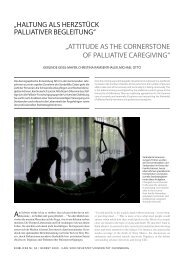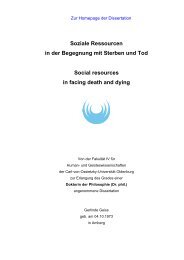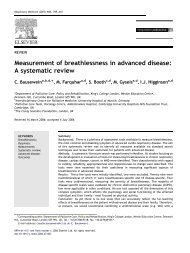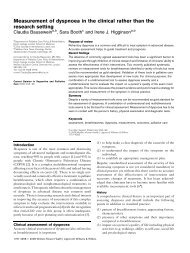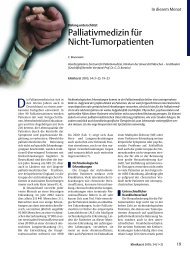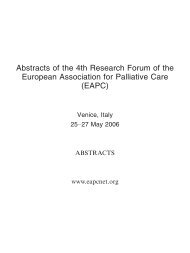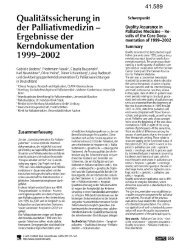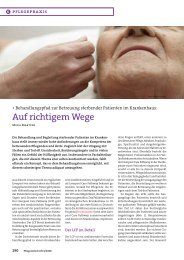EAPC - ipac
EAPC - ipac
EAPC - ipac
You also want an ePaper? Increase the reach of your titles
YUMPU automatically turns print PDFs into web optimized ePapers that Google loves.
424 <strong>EAPC</strong> Abstracts<br />
Background: Evidence based medicine incorporates best available evidence<br />
with clinical experience. Randomized controlled trials (RCT) are the<br />
gold standard for evaluating therapy. The Cochrane Collaboration performs<br />
systematic reviews of RCT evidence. <strong>EAPC</strong> guidelines are based upon<br />
available evidence and expert opinion. Our objective is to review the RCT<br />
evidence for <strong>EAPC</strong> pain management guidelines. Methods: Qualitative<br />
appraisal of systematic reviews from the Cochrane Collaboration. Selected<br />
reviews evaluate cancer or neuropathic pain and opioid or adjuvant analgesics.<br />
Results: RCTs support efficacy of fentany, hydromorphone, morphine,<br />
methadone and nonsteroidal anti-inflammatories in cancer. RCTs do<br />
not support <strong>EAPC</strong> guidelines of morphine as first line opioid, nor recommendations<br />
to titrate only with immediate release. Limited evidence is<br />
available for long term methadone. Only oral transmucosal fentanyl citrate<br />
has been evaluated for breakthrough pain. RCTs refute a predictable relationship<br />
between breakthrough and around the clock opioid dose. No RCTs<br />
evaluate opioid switching for side effects or analgesia. No reviews and very<br />
few RCTs have been performed in neuropathic cancer pain.<br />
Bisphosphonates, radiotherapy and radioisotopes are effective for painful<br />
bony metastases. Single and multiple fraction radiotherapy schedules are<br />
eqianalgesic. Systematic reviews are hampered by heterogeneity of trial<br />
design, pain definition and evaluation, short study duration, lack of pain<br />
classification and limited side effect reporting. Conclusions: Limited RCT<br />
evidence supports <strong>EAPC</strong> cancer pain management guidelines. RCT evidence<br />
refutes guidelines on breakthrough dosing and morphine titration.<br />
Evidence gaps exist comparing opioids (efficacy, adverse effects, pain syndromes)<br />
and guiding management of breakthrough and neuropathic pain.<br />
Strategies to improve RCT evidence in palliative medicine are needed.<br />
Formal criteria for evaluating observational evidence are needed.<br />
83 Oral Presentation<br />
Pain 1<br />
Genetic variation in the Catechol-O-Methyltransferase (COMT)<br />
gene and morphine requirements in cancer pain patients<br />
Authors: Trude Rakvåg Faculty of medicine Cancer research and molecular<br />
medicine NORWAY<br />
Stein Kaasa Norwegian University of Science and Technology and St. Olavs<br />
Hospital Trondheim NORWAY<br />
Frank Skorpen Norwegian University of Science and Technology<br />
Trondheim NORWAY<br />
Joy Ross St Joseph’s Hospice London UNITED KINGDOM<br />
Hiroe Sato Imperial College London UNITED KINGDOM<br />
Pål Klepstad Norwegian University of Science and Technology and<br />
St. Olavs Hospital Trondheim NORWAY<br />
Background: Genetic variation contributes to differences in pain sensitivity<br />
and response to different analgesics. Catecholamines are involved in the<br />
modulation of pain. Catecholamines are partly metabolized by the catechol-<br />
O-methyltransferase (COMT) enzyme. Therefore genetic variability in the<br />
COMT gene may contribute to differences in pain sensitivity and response<br />
to analgesics. It is shown that a polymorphism in the COMT gene, Rs4680<br />
(Val158Met), influence pain sensitivity in human experimental pain and the<br />
efficacy for morphine in cancer pain treatment. In this study we wanted to<br />
investigate if variability in other regions in the COMT gene also contributes<br />
to interindividual variability in morphine efficacy. Methods: We genotyped<br />
11 single nucleotide polymorphisms (SNPs) throughout the COMT gene,<br />
and constructed haplotypes from these 11 SNPs, which were in Hardy-<br />
Weinberg equilibrium. We compared both genotypes and haplotypes against<br />
pharmacological, demographical and patient symptoms measurements in a<br />
Caucasian cancer patient cohort (n=197) receiving oral morphine treatment<br />
for cancer pain. Results: Multivariate analyses showed that the most frequent<br />
haplotype (34.5 %) was associated with lower morphine dose requirements<br />
(p=0.005). Conclusions: This study suggests that genetic variability<br />
in the COMT gene contributes to the efficacy of morphine in cancer pain<br />
patients, and that increased understanding of this variability is reached by<br />
evolving from analyses of a single SNP with haplotype analyses.<br />
84 Oral Presentation<br />
Pain 1<br />
Trends in the use of opioids at the end of life and the expected<br />
effects on hastening death<br />
Authors: Mette Rurup Department of Public and Occupational Health VU<br />
University Medical Center NETHERLANDS<br />
Bregje D Onwuteaka-Philipsen VU University Medical Center, EMGO<br />
institute, Department of Public and Occupational Health Amsterdam<br />
NETHERLANDS<br />
Agnes van der Heide Erasmus MC, Department of Public Health Rotterdam<br />
NETHERLANDS<br />
Sander D Borgsteede VU University Medical Center, Department Clinical<br />
Pharmacology and Pharmacy Amsterdam NETHERLANDS<br />
Paul J van der Maas Erasmus MC, Department of Public Health Rotterdam<br />
NETHERLANDS<br />
Background: Research aims: To study (trends in) opioid use and perceptions<br />
of having hastened the end of life of a patient. Methods: A death<br />
certificate study was done in the Netherlands in 2005 which was similar to<br />
studies done in 2001 and 1995. In 2005, a questionnaire was sent to<br />
6860 physicians who had attended a death. Response rate: 78%. Results:<br />
Physicians in the Netherlands less often administered opioids with the<br />
intention to hasten death in 2005 (3.1% of the non-sudden deaths) than in<br />
2001 and in 1995 (resp. 7% and 10% of the non-sudden deaths). Physicians<br />
gave similar dosages of opioids in each of the study years (79–82% gave<br />
less than 200 oral morphine equivalents when taking into account hastening<br />
the end of life in 1995, 2001 and 2005), but physicians in 2005 less often<br />
thought that life was actually shortened than in 2001 and 1995 (37% in<br />
2005, 50% in 2001, 53% in 1995). Of the physicians in 2005 who did think<br />
the life of the patient was shortened by opioids (regardless of whether it was<br />
intended or merely taken into account), 94% did not give higher dosages<br />
than were in their own opinion required for pain– and symptommanagement.<br />
Physicians in 2005 more often took hastening death into<br />
account when they gave higher dosages of opioids, when the patient experienced<br />
more severe symptoms and with female patients. In older patients<br />
(≥80 years) physicians took the hastening of death into account more often,<br />
but the actual dosages of opioids were lower. Conclusions: Physicians in<br />
2005 less often thought that death was hastened by opioids and they less<br />
often gave opioids with the intention to hasten death than in 2001 and 1995.<br />
Main source of funding: ZonMW.<br />
85 Oral Presentation<br />
Pain 1<br />
Effectiveness of Knowledge Translation Interventions to<br />
Improve Cancer Pain Management: A Systematic Review<br />
Authors: Greta Cummings Faculty of Nursing University of Alberta CANADA<br />
Susan Armijo-Olivo University of Alberta Edmonton CANADA<br />
Patricia Biondo Tom Baker Cancer Center Calgary CANADA<br />
Alison Connors University of Alberta Edmonton CANADA<br />
Neil Hagen Tom Baker Cancer Board, University of Calgary Calgary<br />
CANADA<br />
Lesa Chizawsky University of Alberta Edmonton CANADA<br />
Robin Fainsinger University of Alberta Edmonton CANADA<br />
Carla Stiles Tom Baker Cancer Center Calgary CANADA<br />
Rashmi Dhaubhadel University of Alberta Edmonton CANADA<br />
Background: Despite widespread interest in determining how to implement<br />
best practices in cancer care, no systematic reviews of implementation of<br />
knowledge transfer interventions for cancer pain management were found.<br />
The study purpose was to examine the research literature to determine the<br />
effectiveness of knowledge translation (KT) interventions for changing<br />
behavior, beliefs and knowledge in healthcare practitioners, patients and<br />
family, with the goal of improving clinical outcomes in cancer pain management.<br />
Methods: Extensive electronic database searches (e.g. MEDLINE,<br />
CINAHL, EMBASE, and others), along with manual and website searches,<br />
were performed. Studies that evaluated the effect of KT interventions on



